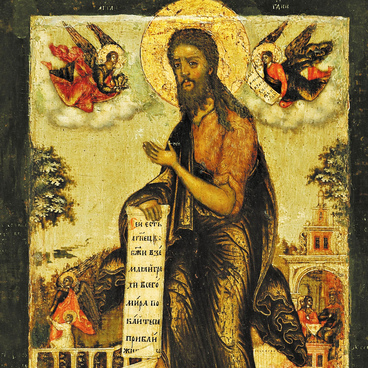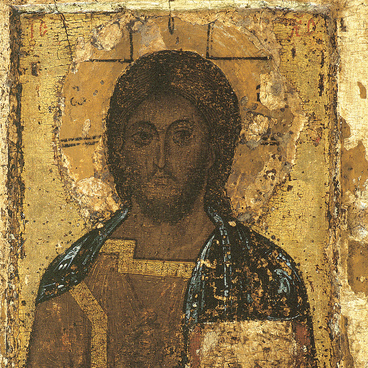The Russian icon of the Savior of Smolensk is based on the Byzantine image of Christ Chalkites. In ancient times, a mosaic with this image decorated the Chalke Gate of the Great Palace of Constantinople. In Russian icon painting, the full-length image of Christ is usually accompanied by saints standing at his feet. The first icon of the Savior of Smolensk was painted in 1514 to celebrate the conquest of Smolensk by Russian forces. This was when the icon was placed above the Spassky (Frolovsky) Gate.
This event occurred on August 1 (14), the day of the Procession of the Precious Wood of the Life-Giving Cross of the Lord (All-Merciful Savior) when the Church remembers the suffering of the Savior on the cross. This explains the iconography of the image. Christ Pantocrator makes a blessing gesture with his right hand and holds an open book of Gospels in the left one. To both sides of the halo are angels holding instruments of the Passion, and at the Savior’s feet are Myrrh-Bearing Women Martha and Mary.
In 1521, following the advice of Sigismund of Poland, Khan Mehmed Giray led the forces of Crimea and Kazan to Moscow. They crossed the Oka River and started plundering the monasteries and villages near Moscow. Vasili III was in Volokolamsk, waiting for reinforcements from Novgorod. This is when a blind nun in the Ascension Monastery had a vision of the Assembly of Moscow Saints leaving the city through the Spassky Gate and taking along the Vladimir Icon of the Mother of God. After citizens prayed in front of the icon, Sergius of Radonezh and Barlaam of Khutyn stopped the saints and returned them to the city. The very same day Mehmed Giray’s forces withdrew from the walls of the Kremlin. To commemorate this event, a fresco of the Savior of Smolensk was placed above the Spassky Gate. The figures of Myrrh-Bearing Women were replaced by the images of Saints Barlaam and Sergius. The open book of the Gospels was depicted with the words,
This event occurred on August 1 (14), the day of the Procession of the Precious Wood of the Life-Giving Cross of the Lord (All-Merciful Savior) when the Church remembers the suffering of the Savior on the cross. This explains the iconography of the image. Christ Pantocrator makes a blessing gesture with his right hand and holds an open book of Gospels in the left one. To both sides of the halo are angels holding instruments of the Passion, and at the Savior’s feet are Myrrh-Bearing Women Martha and Mary.
In 1521, following the advice of Sigismund of Poland, Khan Mehmed Giray led the forces of Crimea and Kazan to Moscow. They crossed the Oka River and started plundering the monasteries and villages near Moscow. Vasili III was in Volokolamsk, waiting for reinforcements from Novgorod. This is when a blind nun in the Ascension Monastery had a vision of the Assembly of Moscow Saints leaving the city through the Spassky Gate and taking along the Vladimir Icon of the Mother of God. After citizens prayed in front of the icon, Sergius of Radonezh and Barlaam of Khutyn stopped the saints and returned them to the city. The very same day Mehmed Giray’s forces withdrew from the walls of the Kremlin. To commemorate this event, a fresco of the Savior of Smolensk was placed above the Spassky Gate. The figures of Myrrh-Bearing Women were replaced by the images of Saints Barlaam and Sergius. The open book of the Gospels was depicted with the words,



